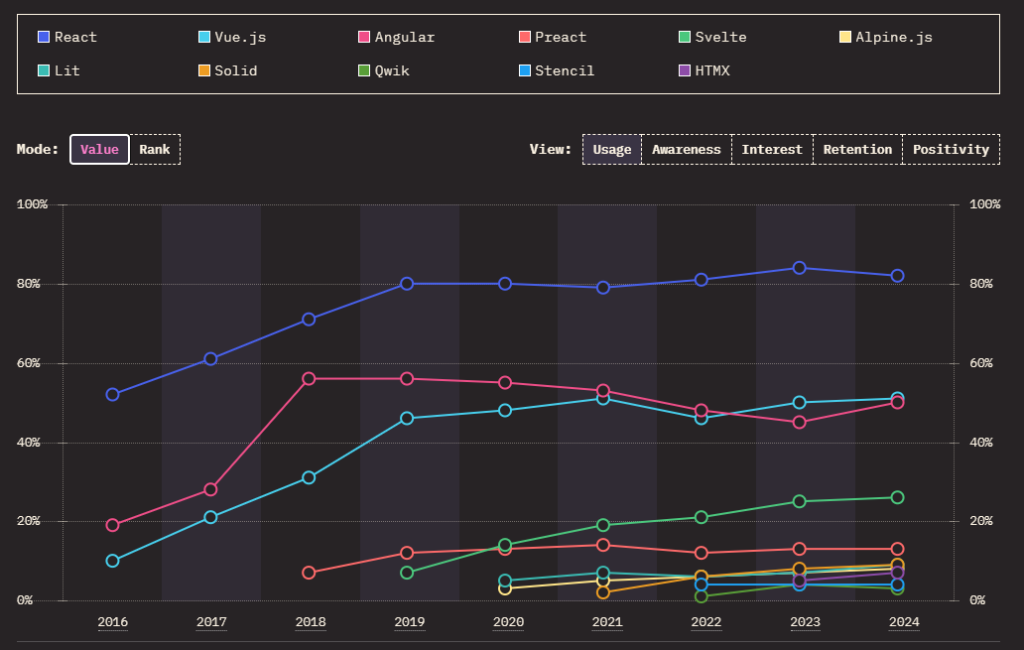As someone who is diving into React or wants to build something using React, before choosing React, it is important to know the pros and cons of React before deciding whether to proceed or go with some other library.
Why is it worth using React? What advantages this JavaScript library has over other libraries?
Let’s learn the pros and cons of react library before choosing this popular library…

What Will You Learn?
Why React Is Popular?
React.js is the most popular frontend JavaScript library – it is proven by trends among the biggest tech websites (ex. GitHub, Stack Overflow) and by the number of job offers.
A recent 2024 survey on the state of JS shows that the most used front-end framework is React.

React created by Facebook is a project with great marketing, with low entry threshold (ex. comparing to Angular), a large community, and awesome portability that (React + React Native) gives us.
Pros and Cons of React
While most articles focus on the advantages of React – In this blog, I will start with the disadvantages of React first and where you can find difficulty when starting your project with React or learning React.
When starting with React, it looks very comfortable to ease into. You can immediately start a project with React. That said, this doesn’t promise that things won’t get more complicated in the future.
Disadvantages of React
Development Pace
React JS is constantly evolving and changing. The pace at which React is developed can be seen as an advantage or a disadvantage depending on who you are.
The developers who see the pace of development as a disadvantage would argue that they have to constantly relearn how to work with React JS, which is difficult to keep up with.
Here I am listing some React versions with their release time,
v18.3.1 (April, 2024)
v18.3.0 (April, 2024)
v18.2.0 (June, 2022)
v18.1.0 (April, 2022)
v18.0.0 (March 2022)
v17.0.2 (March 2021)
v17.0.1 (October 2020)
v17.0.0 (October 2020)
v16.14.0 (October 2020)
v16.13.1 (March 2020)
v16.13.0 (February 2020)
v16.12.0 (November 2019)
v16.11.0 (October 2019)
v16.10.2 (October 2019)
v16.10.1 (September 2019)
v16.10.0 (September 2019)From this, you can see that React is always changing and improving which might make you relearn things again and again.
Lack of Documentation
This drawback is tied to people’s concern with the pace of React’s development.
As a result of rapid development, educational documentation, and resources can be sparse in covering the latest updates and changes.
Since ReactJS is an open-source framework, developers can create their support documents, but since anyone can create these resources, you could come across poor resources that offer little help.
Just Focusing on UI
React contains a myriad of tools used to develop and create user interfaces. However, unlike frameworks, React JS is not an ‘all-in-one-tool’ for app development.
Therefore, if you happen to use a model-view-controller (MVC), React development is only responsible for the UI.
You will need additional tools for app programming interfaces (APIs), routing, and other parts as well.
JSX Code
In simple terms, JSX is a JavaScript extension that can make the code more readable and clean.
While the JSX syntax extension makes things easier for some developers, other web developers and designers find the JSX code too complex and challenging to grasp.
Lack of In-built Tooling
Businesses should understand that the horizon of React only covers the UI layer of the application. Other than this, everything related to the web development project is out of its periphery.
Thus, even after implementing React web app development, the developers still need to choose a framework to build fast, beautiful, and compatible UI.
Since the entire tooling set is not available only with React, the developers will face difficulties completing the project.
Want to find some good UI libraries for your project? Here is a list of UI libraries that you can use for your next project.
If none of these disadvantages are stopping you from learning React or using React for your project, then let’s dive into the advantages you will get by using React.
Advantages of React
Efficiency of React
By minimizing the number of updates to the real DOM, React significantly improves the performance of web applications.
This results in faster load times, smoother user interactions, and a more responsive user interface.
In essence, Reacts efficiency is about doing the least amount of work necessary to keep the user interface up-to-date, which is particularly beneficial for applications with dynamic content that frequently changes.
Reusable Components
In React, everything is built as a component. A component is a self-contained piece of code that encapsulates a specific part of the user interface.
The key advantage of components in React is their reusability. Once you create a component, you can use it multiple times within the same application or even across different projects.
Overall, the concept of reusable components in React promotes a more efficient, organized, and collaborative development process.
Community and Ecosystem
React has a large and active community of developers, both individual enthusiasts and professionals from various companies and organizations.
The React community is known for its willingness to share knowledge and experiences. Developers frequently create and share tutorials, articles, videos, and documentation.
React itself is an open-source library, and many additional libraries and tools built to complement React are also open-source.
This open-source nature encourages collaboration, innovation, and the continuous improvement of the React ecosystem.
SEO Friendly
React applications can implement server-side rendering, which means that the initial rendering of the web page occurs on the server rather than in the user’s browser.
This server-side rendering ensures that search engine bots can easily crawl and index the content, improving the website’s SEO.
Reacts component-based structure allows developers to create accessible user interfaces.
Search engines consider accessibility a positive ranking factor, so Reacts support for accessible development can improve SEO.
Cross-platform Functionalities
Another surprising outcome of React is the spin-off framework called React Native, created for cross-platform mobile application development.
In addition, it uses React JS for dedicated mobile application development. One of its most astonishing benefits is that with React Native, you write one code for both platforms, iOS and Android.
React Native apps are known for their excellent performance because they use native components and are optimized for each platform.
High Compatibility
React is created to work seamlessly with other JS libraries and does not limit the possibility of using additional tools for website creation.
It allows you to choose any suitable React extension that, with the help of outside controllers, will define the view layer of the page.
Coupling React with third-party libraries makes building websites a breeze. Additionally, React works great with any back-end tech stack you need.
Scalability
React’s modular design makes it easier to scale than many other platforms.
Simply adding components, replacing old ones with more robust versions, and making application changes piecemeal rather than wholesale makes ramping up an application to meet demands and improvements more straightforward and safer too.
Scaling up from a rapidly prototyped MVP into a full-scale production application is possible due to the feature set and design.
Check out this video where he explains when and why he uses React…
Conclusion
Even React as the most popular library has its advantages and drawbacks. Whether you should proceed with React or with some other front-end libraries, depends on your project requirements and personal opinions.
But before choosing between React or not React, remember the points described in this blog.
Thank you, see you soon!

